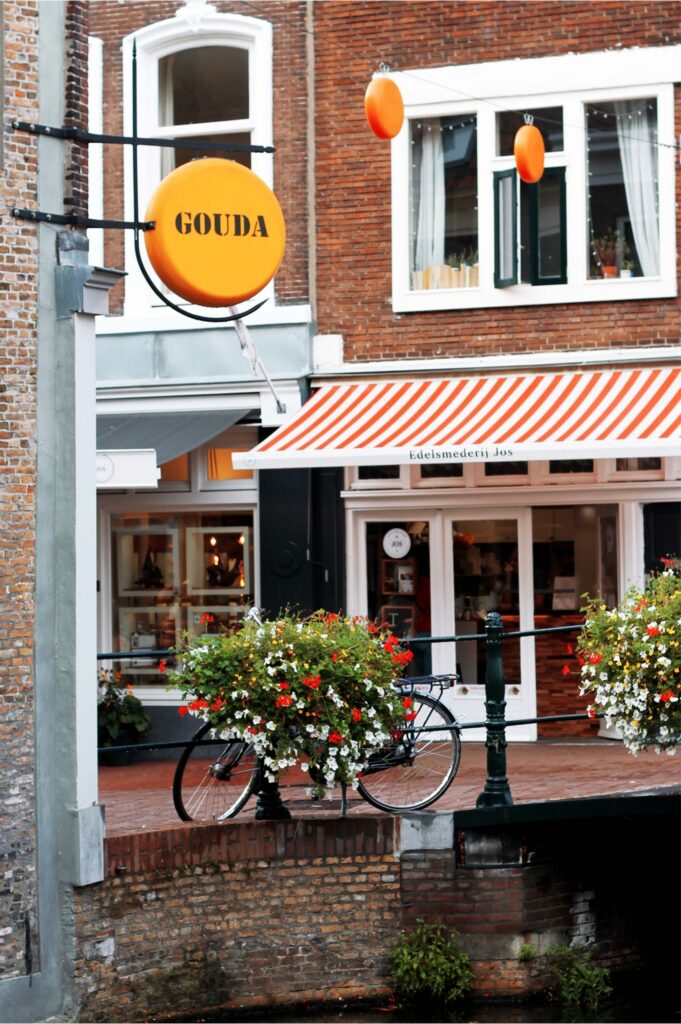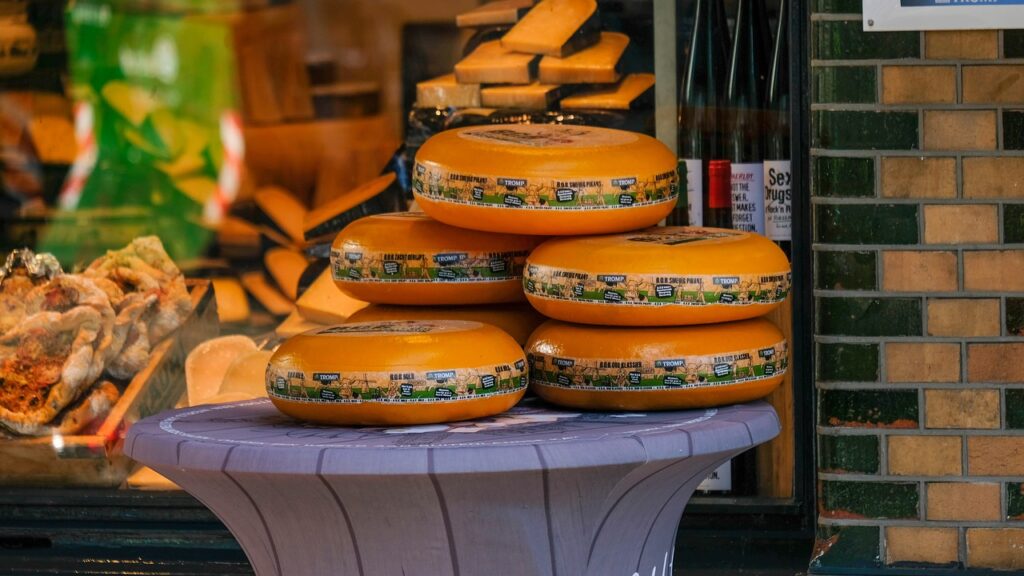Gouda is a Dutch cheese that belongs to the uncooked pressed cheeses type. It is probably the most popular cheese in the Netherlands, along with Edam. This dairy product is made from pasteurized, skimmed whole cow’s milk. We recognize it thanks to the distinctive orange color of its rind, although other types of Gouda exist. Indeed, we can find this cheese with a white rind, a yellow rind and even a red rind. You didn’t know that, did you?
In this article, the experts from Paroles de Fromagers tell you everything you need to know about gouda cheese. Let’s learn how to store it properly, how to pair it, how to cut it and much more… Here we go!

What is the origin of Gouda cheese?
It won’t be a surprise for you if we tell you that this cow’s milk cheese gets its name from the town Gouda, in Holland. Is it? Well, it is true. In Europe, this product became very popular from the 12th century… That’s how far back its history goes! Gouda is therefore an old cheese. Back then, gouda was made by farmers in the surrounding polders (which are artificial stretches of land reclaimed from the water). Artisan cheese makers from the farms would bring their cheeses to the city center to sell them on the market.
Since then, this Dutch cheese won the hearts of Europeans, but also Americans. You love it, we know it!
Now that you know more about the story of the origin of gouda, here are some key points to know about this cheese.
How and how can you store Gouda cheese?
This cheese from Holland can be kept for up to 10 days if it is young and 15 days to 3 weeks if it is old. In order to keep it fresh and to guarantee an exquisite flavor, we recommend you put it in an airtight bow in the refrigerator. Ideally, it is preferable to wrap it in the cheese maker’s paper before. If you follow these tips, you will be able to store your gouda for about 15 days without any trouble or any alteration of the taste.
However, be careful! The longer you wait to eat this cheese, the more it loses the flavors. Do not let it sit for too long in the fridge!
How to cut gouda cheese?
Gouda cheese is an excellent addition to a beautiful cheese platter because of its original orange color. It brings up color and a touch of pep to the visual. Moreover, as far as we know, it is a cheese that generally pleases most people.
To cut gouda properly, we recommend you use a sharp knife without teeth. It is imperative to respect the heart-rind rule when cutting this cheese. Of course, if you are fond of this dairy product, you can cut it in classic pieces, it is not forbidden! The golden rule remains: you treat yourself and please your guests.
Which condiment goes best with gouda cheese?
You might ignore it, but… gouda cheese goes wonderfully with a juicy pear and wholemeal bread. An original and surprising pairing that will be of great interest at your dinner parties. On a cheese platter, you can place a few slices of pear next to your cheese and let your guests help themselves. Yummy!
What are the best recipes with Gouda cheese?
Want to try some original dish recipes with these uncooked pressed cheeses? Some mouth-watering ideas are coming… It is true. Gouda is quite popular when it comes to preparing some cheesy dishes at home in America. But hey! Remember… There is much more than burgers with gouda cheese! 😉 Here come some ideas:
- Potato, bacon and Gouda gratin: yum… it is more of a winter recipe idea that will delight the greediest people among you!
- Pasta with grated gouda: simple and efficient! Gouda pasta is a great alternative to Emmental, Comté or Gruyère pasta. Think about it!
- Butternut-Gouda pot stickers… These appetizers are so delicious!
- Cold sandwich with 2 cheeses and ham or chicken: combine emmental with gouda in this recipe and make a delicious French sandwich!

What is the difference between mimolette and gouda?
As far as we know, a lot of cheese lovers tend to confuse these two cheeses because of their orange color. In order to help you, here is a small summary of the main differences between gouda and mimolette:
- Mimolette has an orange rind and a bright orange paste. Gouda has a white paste.
- Gouda cheese is often coated with paraffin, so it won’t lose weight during transport. It is not the case for mimolette.
- Moreover, to clear your mind, mimolette is a French cheese. Gouda comes from Holland.
- Gouda dates back to the Middle-Age, while mimolette was born in the 17th century in France.
P.S : The trick of coating gouda with paraffin came from the first exporters of gouda in the Netherlands. An ingenious way to keep the quality of the cheese during the journey. Dutch people are quite smart, aren’t them?
Can I eat gouda if I’m pregnant?
The answer is yes, of course. As told before, gouda cheese is made of pasteurized milk, so there is no problem for pregnant women.
What are the types of gouda?
The type of gouda cheese mostly depends on the affinage (the aging process) during the cheese making process. Industrial goudas affinage generally last 3 months only. On the other hand, you can find an extra aged gouda, sometimes called ‘Christmas Gouda’. The affinage lasts up to 36 months for this type. That is a type of gouda that you can find exclusively in cheese shops, such as Paroles de Fromagers. Young gouda has a fruity and buttery flavor, while the old gouda will have a more pungent and pronounced flavor. It is up to you!
Rendez-vous in our workshops and classes
We hope you’ve learned everything you needed to know about Gouda, one of the most famous European cheeses. Wanna learn how to make your own cheese? Please, check out our workshops and cheese making classes with our French experts located in Paris, France!









